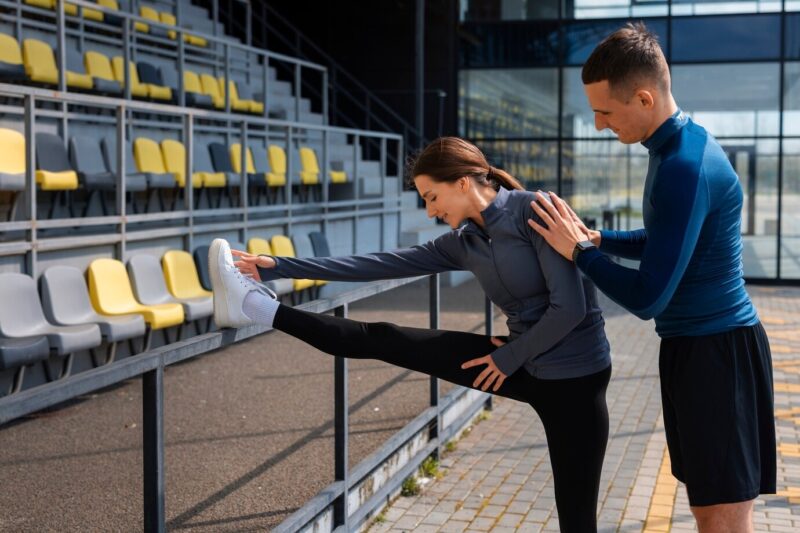Stretching has long been a cornerstone of physical fitness and wellness, advocated for its benefits in increasing flexibility, reducing muscle tension, and potentially lowering the risk of injury.
However, like all things, it is possible to have too much of a good thing. Overstretching, or stretching beyond the muscles’ capacity to handle, can lead to discomfort, decreased performance, and even injury. This article explores the fine line between beneficial stretching and overstretching, offering insights and tips to maintain a healthy balance.
Understanding Stretching
Before diving into the nuances of overstretching, it’s crucial to understand the basics of stretching itself. Stretching involves elongating the muscles to enhance flexibility and range of motion.
There are several types of flexibility training techniques, including static, dynamic, ballistic, and proprioceptive neuromuscular facilitation (PNF). Each type serves different purposes and is suited to different activities and times within a workout regimen.
The Benefits of Proper Stretching

Proper stretching, when done correctly, can yield numerous benefits. It can improve flexibility, increase range of motion, help in muscle recovery, and even aid in stress reduction.
Flexibility training before and after workouts can prepare the muscles for activity and help in cooldown, reducing the likelihood of post-exercise soreness. Learn more about the benefits of proper stretching at Castle Flexx and learn how is it done correctly.
The Risks of Overstretching
Overstretching occurs when the muscles are stretched beyond their capacity, leading to potential muscle or tendon strain. This can happen when the intensity of a stretch is too high, the duration is too long, or the body is not adequately warmed up. Overstretching can lead to decreased muscle control, stability, and strength, increasing the risk of injury.
Recognizing Overstretching
To avoid the pitfalls of overstretching, it’s essential to recognize its signs and symptoms. These can include:
- Sharp or severe pain during or after flexibility training
- Joint instability or muscle weakness
- Decreased range of motion due to pain or injury
- Muscle or tendon strains
- Feeling of numbness or tingling in the stretched limbs
Understanding these signs can help in identifying when you might be pushing your limits too far.
How Much Stretching Is Enough?

Determining the right amount of stretching is subjective and varies based on individual fitness levels, flexibility, and the specific activity or sport. However, a general guideline is to engage in flexibility training exercises that produce a slight tension in the muscles without causing pain. Stretching should be held for about 15 to 30 seconds for most adults, and each major muscle group should be stretched 2 to 3 times.
The Role of Warm-Up
A proper warm-up is crucial before engaging in more intense stretching or physical activity. Warm-up exercises increase blood flow to the muscles, making them more pliable and less prone to injury. A combination of light aerobic activity and dynamic stretches is recommended to prepare the body for more intensive flexibility training or exercise.
Listening to Your Body
One of the most important aspects of stretching, and exercise in general, is to listen to your body. Everyone’s limits are different, and what might be a moderate stretch for one person could be overstretching for another. Paying attention to how your body feels during and after flexibility training can help in recognizing your personal boundaries.
Tips for Avoiding Overstretching

To maintain a healthy stretching routine without crossing into overstretching, consider the following tips:
Gradual Progression
Increase the intensity and duration of your stretches gradually. If you’re new to stretching or returning after a break, start slowly and build up your flexibility over time.
Understand Proper Technique
Incorrect flexibility training techniques can easily lead to overstretching. Educate yourself on the correct form for each stretch, and consider consulting with a fitness professional or physical therapist.
Incorporate Variety
Vary your stretching routine to include different types of stretches and focus on different muscle groups. This approach not only prevents boredom but also ensures a more balanced increase in flexibility.
Prioritize Rest and Recovery
Allow your muscles time to recover between stretching sessions, especially if you’re engaging in intense or prolonged flexibility training. Rest is as crucial as the exercise itself for muscle recovery and growth.
Avoid Bouncing

Bouncing while stretching, known as ballistic stretching, can increase the risk of overstretching and injury. Opt for static or dynamic flexibility training, where movements are controlled and gradual.
Balance Flexibility and Strength
While flexibility is important, it should be balanced with muscle strength. Incorporating strength training into your routine can help support the muscles and joints, reducing the risk of injury from overstretching.
Be Mindful of Pre-existing Conditions
If you have any pre-existing conditions or injuries, be extra cautious with stretching. Consult with a healthcare provider for personalized advice and modifications to avoid exacerbating any issues.
Customizing Your Stretching Routine
Creating a stretching routine that caters to your individual needs and goals is essential for avoiding overstretching. Not all flexibility training routines are suitable for everyone; factors like age, fitness level, and specific sports or activities play a significant role in determining the most beneficial stretches.
For instance, a dancer might need a different stretching regimen compared to a runner or a weightlifter. Tailoring your routine involves selecting stretches that target the muscle groups most used in your activities and adjusting the intensity and duration to match your current flexibility level.
Seeking Professional Guidance

When in doubt, seeking advice from professionals can be invaluable in preventing overstretching. Physical therapists, certified personal trainers, and sports coaches possess the expertise to recommend stretches and routines that align with your physical capabilities and goals.
They can also guide proper technique and help you make adjustments to avoid injury. Investing time in professional guidance can pay off by ensuring that your stretching practices are both safe and effective.
Closing Thoughts
Stretching is an integral part of maintaining a healthy, active lifestyle, offering numerous benefits from improved flexibility to enhanced muscle recovery. However, it’s vital to approach flexibility training with awareness and caution to prevent the pitfalls of overstretching.
By recognizing the signs of overstretching, listening to your body, and incorporating the tips provided, including gradual progression, proper technique, and balance between flexibility and strength, you can enjoy the benefits of flexibility training without risk.
Related Posts:
- How Much Penis Enlargement Cost? Methods, and Considerations
- How Much Caffeine in a Shot of Espresso:…
- How to Calculate Personal Injury Claim: Tips for…
- The Toughest Relationship Phase: Tips for Overcoming…
- Moving with a Baby Stress-Free: Essential Tips for a…
- How To Use Leaflets as a Marketing Tool? 10 Tips and…















